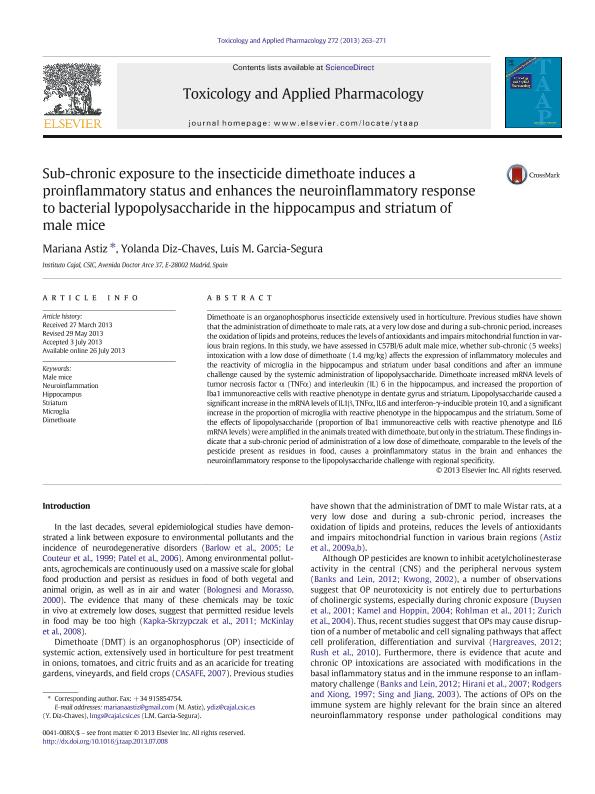Mostrar el registro sencillo del ítem
dc.contributor.author
Astiz, Mariana

dc.contributor.author
Diz Chaves, Yolanda
dc.contributor.author
Garcia Segura, Luis Miguel

dc.date.available
2017-09-15T17:06:42Z
dc.date.issued
2013-10-15
dc.identifier.citation
Astiz, Mariana; Diz Chaves, Yolanda; Garcia Segura, Luis Miguel; Sub-chronic exposure to the insecticide dimethoate induces a proinflammatory status and enhances the neuroinflammatory response to bacterial lypopolysaccharide in the hippocampus and striatum of male mice; Academic Press Inc Elsevier Science; Toxicology and Applied Pharmacology; 272; 2; 15-10-2013; 263-271
dc.identifier.issn
0041-008X
dc.identifier.uri
http://hdl.handle.net/11336/24388
dc.description.abstract
Dimethoate is an organophosphorus insecticide extensively used in horticulture. Previous studies have shown that the administration of dimethoate to male rats, at a very low dose and during a sub-chronic period, increases the oxidation of lipids and proteins, reduces the levels of antioxidants and impairs mitochondrial function in various brain regions. In this study, we have assessed in C57Bl/6 adult male mice, whether sub-chronic (5 weeks) intoxication with a low dose of dimethoate (1.4 mg/kg) affects the expression of inflammatory molecules and the reactivity of microglia in the hippocampus and striatum under basal conditions and after an immune challenge caused by the systemic administration of lipopolysaccharide. Dimethoate increased mRNA levels of tumor necrosis factor α (TNFα) and interleukin (IL) 6 in the hippocampus, and increased the proportion of Iba1 immunoreactive cells with reactive phenotype in dentate gyrus and striatum. Lipopolysaccharide caused a significant increase in the mRNA levels of IL1β, TNFα, IL6 and interferon-γ-inducible protein 10, and a significant increase in the proportion of microglia with reactive phenotype in the hippocampus and the striatum. Some of the effects of lipopolysaccharide (proportion of Iba1 immunoreactive cells with reactive phenotype and IL6 mRNA levels) were amplified in the animals treated with dimethoate, but only in the striatum. These findings indicate that a sub-chronic period of administration of a low dose of dimethoate, comparable to the levels of the pesticide present as residues in food, causes a proinflammatory status in the brain and enhances the neuroinflammatory response to the lipopolysaccharide challenge with regional specificity
dc.format
application/pdf
dc.language.iso
eng
dc.publisher
Academic Press Inc Elsevier Science

dc.rights
info:eu-repo/semantics/openAccess
dc.rights.uri
https://creativecommons.org/licenses/by-nc-sa/2.5/ar/
dc.subject
Dimethoate
dc.subject
Hippocampus
dc.subject
Male Mice
dc.subject
Microglia
dc.subject
Neuroinflammation
dc.subject
Striatum
dc.subject.classification
Bioquímica y Biología Molecular

dc.subject.classification
Medicina Básica

dc.subject.classification
CIENCIAS MÉDICAS Y DE LA SALUD

dc.title
Sub-chronic exposure to the insecticide dimethoate induces a proinflammatory status and enhances the neuroinflammatory response to bacterial lypopolysaccharide in the hippocampus and striatum of male mice
dc.type
info:eu-repo/semantics/article
dc.type
info:ar-repo/semantics/artículo
dc.type
info:eu-repo/semantics/publishedVersion
dc.date.updated
2017-09-14T13:56:11Z
dc.journal.volume
272
dc.journal.number
2
dc.journal.pagination
263-271
dc.journal.pais
Países Bajos

dc.journal.ciudad
Amsterdam
dc.description.fil
Fil: Astiz, Mariana. Instituto Cajal; España. Consejo Nacional de Investigaciones Científicas y Técnicas; Argentina
dc.description.fil
Fil: Diz Chaves, Yolanda. Instituto Cajal; España
dc.description.fil
Fil: Garcia Segura, Luis Miguel. Instituto Cajal; España
dc.journal.title
Toxicology and Applied Pharmacology

dc.relation.alternativeid
info:eu-repo/semantics/altIdentifier/doi/http://dx.doi.org/10.1016/j.taap.2013.07.008
dc.relation.alternativeid
info:eu-repo/semantics/altIdentifier/url/http://www.sciencedirect.com/science/article/pii/S0041008X13003116
Archivos asociados
